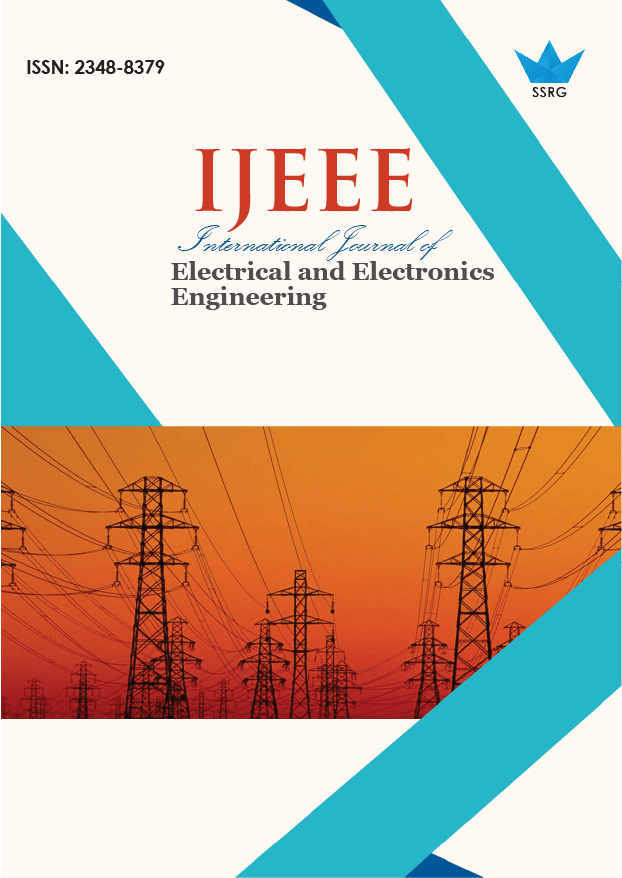Therapeutic Use of Portable Electrotherapy Machine for Muscle Stimulation, Education and Healing

| International Journal of Electrical and Electronics Engineering |
| © 2025 by SSRG - IJEEE Journal |
| Volume 12 Issue 3 |
| Year of Publication : 2025 |
| Authors : Mahesh Kolte, Deepti Khurge, Prachi Palsodkar, Roshan Umate, Arnav Kulkarni, Shubham Joshi, Anjali Kolte, Sanjay Babar |
How to Cite?
Mahesh Kolte, Deepti Khurge, Prachi Palsodkar, Roshan Umate, Arnav Kulkarni, Shubham Joshi, Anjali Kolte, Sanjay Babar, "Therapeutic Use of Portable Electrotherapy Machine for Muscle Stimulation, Education and Healing," SSRG International Journal of Electrical and Electronics Engineering, vol. 12, no. 3, pp. 55-62, 2025. Crossref, https://doi.org/10.14445/23488379/IJEEE-V12I3P106
Abstract:
Electrotherapy makes use of well-controlled electrical pulses of various durations as per the patients’ requirements either for muscle relaxation, muscle re-education, muscle stimulation, as well as muscle strengthening. The major advantage of a portable stimulator is that the clinician can carry it and use it whenever necessary. The proposed machine contains all types of currents in a very portable and handy unit. The nature of the current used in experimentations, along with various parameters such as intensity, duration, frequency, arrangement of electrodes, and sizes, can induce explicit physiological effects on targeted tissues. Electrical currents have a direct impact on excitable tissues like muscle fibres, cell membranes and nerves. These effects help manage both acute and chronic pain, decrease edema, alleviate joint contractures, prevent muscle spasms, combat disuse atrophy, promote tissue healing, assist in muscle re-education, aid in fracture healing, and strengthen muscles, even serving as an orthotic substitute. Electrical stimulation can even be applied to trigger muscle contractions during activities like gait training.
Keywords:
Electrical stimulation, Electrotherapy, Muscle stimulation, Pain relief.
References:
[1] Tim Watson, “Key Concepts in Electrotherapy,” Physiopedia, pp. 1-9, 2014.
[Google Scholar] [Publisher Link]
[2] William D. Stanish et al., “The Use of Electricity in Ligament and Tendon Repair,” The Physician and Sportsmedicine, vol. 13, no. 8, pp. 109-116, 1985.
[CrossRef] [Google Scholar] [Publisher Link]
[3] R. Newton, “High-Voltage Pulsed Galvanic Stimulation: Theoretical Bases and Clinical Applications,” Clinical Electrotherapy, pp. 165 182, 1987.
[Google Scholar]
[4] Donald M. Dooley, and Mary Kasprak, “Modification of Blood Flow to the Extremities by Electrical Stimulation of the Nervous System,” Southern Medical Journal, vol. 69, no. 10, pp. 1309-1311, 1976.
[CrossRef] [Google Scholar] [Publisher Link]
[5] Geddes L.A., “A Short History of the Electrical Stimulation of Excitable Tissue Including Electrotherapeutic Applications,” The Physiologist, vol. 27, no. 1, pp. S1-S47, 1984.
[CrossRef] [Google Scholar] [Publisher Link]
[6] Dean P. Currier, and Roger M. Nelson, Clinical Electrotherapy, Appleton and Lange, 1987.
[7] L.L. Baker, “Clinical uses of Neuromuscular Electrical Stimulation,” Clinical Electrotherapy, pp. 143-170, 1991.
[Google Scholar]
[8] John Low, Electrotherapy Explained Principles and Practice, 4th ed., Elsevier, 2025.
[Google Scholar] [Publisher Link]
[9] Chad Starkey, Therapeutic Modalities, 4th ed., F.A. Davis Company, 2025.
[Google Scholar] [Publisher Link]
[10] B.K. Choudhury, and A.K. Bose, A Handbook of Physiotherapy, Jaypee Brothers Medical Publishers (P) Ltd, 2006.
[Publisher Link]
[11] Simmi K. Ratan et al., “The Surged Faradic Stimulation to the Pelvic Floor Muscles as an Adjunct to the Medical Management in Children with Rectal Prolapse,” BMC Pediatrics, vol. 9, no. 44, pp. 1-6, 2009.
[CrossRef] [Google Scholar] [Publisher Link]
[12] Jennifer Bending, “TENS Relief of Discomfort ‘Like Worms Wriggling Under the Skin,” Physiotherapy, vol. 79, no. 11, pp. 773-774, 1993.
[Google Scholar] [Publisher Link]
[13] O. Tashani, and M.I. Johnson, “Transcutaneous Electrical Nerve Stimulation (TENS) A Possible Aid for Pain Relief in Developing Countries?,” Libyan Journal of Medicine, vol. 4, no. 2, pp. 62-65, 2008.
[CrossRef] [Google Scholar] [Publisher Link]
[14] Dana L. Dailey et al., “Transcutaneous Electrical Nerve Stimulation Reduces Movement-Evoked Pain and Fatigue: A Randomized, Controlled Trial,” Arthritis & Rheumatology, vol. 72, no. 5, pp. 824-836, 2020.
[CrossRef] [Google Scholar] [Publisher Link]
[15] G.C. Goats, “Interferential Current Therapy,” British Journal of Sports Medicine, vol. 24, no. 2, pp. 87-92, 1990.
[CrossRef] [Google Scholar] [Publisher Link]
[16] M. Hogenkamp et al., “Interferential Therapy,” Rotterdam, Netherlands: B.V. Enraf-Nonius, 2005.
[Google Scholar]
[17] Jagmohan Singh, Textbook of Electrotherapy, 2nd ed., Jaypee Brothers Medical Publishers (P) Ltd, 2005.
[Google Scholar] [Publisher Link]
[18] Po-Yin Chen, “Clinical Applications and Consideration of Interventions of Electrotherapy for Orthopedic and Neurological Rehabilitation,” Journal of the Chinese Medical Association, vol. 85, no. 1, pp. 24-29, 2022.
[CrossRef] [Google Scholar] [Publisher Link]
[19] Alfred G. Bracciano, Principles of Electrotherapy, Routledge, 2022.
[Google Scholar] [Publisher Link]
[20] Carla Marina Bastos et al., “The Challenge in Combining Pelotherapy and Electrotherapy (Iontophoresis) in One Single Therapeutic Modality,” Applied Sciences, vol. 12, no. 3, pp. 1-19, 2022.
[CrossRef] [Google Scholar] [Publisher Link]
[21] Alin Petras et al., “Using Portable Ultrasound to Monitor the Neuromuscular Reactivity to Low-Frequency Electrical Stimulation,” Diagnostics, vol. 11, no. 1, pp. 1-12, 2021.
[CrossRef] [Google Scholar] [Publisher Link]

 10.14445/23488379/IJEEE-V12I3P106
10.14445/23488379/IJEEE-V12I3P106